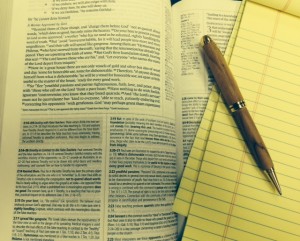
Through his careful research and later book, The Shape of Faith To Come, Brad Waggoner and his research team identified daily Bible study as the number one indicator of Christian maturity. If you want to grow in Christ, it seems, the best way to do that is to spend time with him in his Word. Paul admonished the Romans 12:2, “Do not be conformed to this world, but be transformed by the renewal of your mind, that by testing you may discern what is the will of God, what is good and acceptable and perfect.”
The best way to be transformed and renewed in your mind is to fill it with the transforming Word of God. A good study Bible is one of the best tools to have in your Christian tool box to help you better read, understand, and apply the Word of God. My first study Bible was a gift from my brother. I still own my black leather Nelson New King James Study Bible. In fact, I preached from it until the pages began to fall out en-masse. For me, that Bible served as a solace through many storms of life. The Word taught me, and the study notes helped me to understand and apply the Word more diligently.
During my college years, that Study Bible was my saving grace against liberal theology that threatened my evangelical convictions. On many occasions, I sat in classrooms with professors who questioned the authority of the Scripture, the authorship of the scripture, and the plain-text reading of the scripture. As I read the text, I was convinced that they were wrong, but in the face of such learned professors I was ill-prepared to rebut their arguments, save for the study notes beneath the sacred text in my study Bible. Because of the cross-references, I was able to turn back and forth in the Bible and see the way the big picture fit together. The maps gave me confidence that the Israelites could have crossed the Red Sea and not merely the pithy Reed Sea. The study notes assured me that it was plausible to believe that Moses had written the first five books of the Old Testament and encouraged me with the reality that I was not alone in my interpretation. Though my professors and classmates may have disagreed with me, I could know that I was not alone in the world–the editors of and contributors to the NKJV Study Bible also believed the Bible to be the infallible and inerrant Word of God. In those years, a Study Bible was my saving grace, but it was also my preferred study tool in the early years of ministry. As I prepared Bible studies and sermons, the first place I went was to my Nelson Study Bible.
Today, my approach is similar. Outside of the sacred Word, the first place I turn in my research is a study Bible. Now I lean heavily upon the ESV Study Bible. It is my first commentary and cross-reference tool, and I encourage it to be yours as well. A few years ago, Albert Mohler wrote about how to use a study Bible. I found his three steps to be very helpful,
- Read the text of the Bible first. Meditate upon the text and read it with care. Apply your own knowledge of the Bible in order to understand the particular text within its context and place in the biblical story-line. Consider and note other texts that come to your mind as directly related to this text. Read the text with full attention and conviction.
- Look carefully at the cross-references that the study Bible links to the text you are reading. Do not look only to the citations, but read the actual passages. This assistance is still the main contribution of a study Bible — making related and parallel passages more accessible. A first principle of interpreting the Bible is to interpret the Bible by the Bible. In other words, to allow the Bible to interpret itself text by text.
- As a third step, take full advantage of the notes, articles, and other helps printed alongside the text. In some cases, short articles will help in understanding contested issues or matters that might otherwise require a Bible dictionary or encyclopedia. Where appropriate, maps can be very useful, along with tables of measurement and similar points of reference. The very best of the study Bibles will also offer some level of commentary within the notes.
Note that the first step is always to be in the text of the Bible first, not the notes, maps, or the introductions. The Word of God alone is inerrant and infallible. The study-helps in your Bible are there as an aid, but should never be seen as equal to or a replacement for the text of the Bible itself. Nevertheless, when used properly, a good study Bible is nearly irreplaceable in the hands of a believer eager to understand and apply God’s Word.

